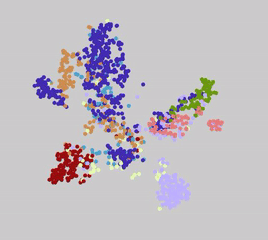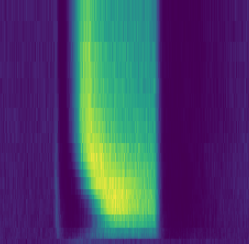This supervised model, implemented in C++, was built to classify mouse retinal ganglion cells according to their physiological response properties. Full data, results, and further references are available in the RGCTypes.org online gallery.
Under construction spots of light of various sizes and constant luminance centered on the cell's receptive field responses are upsampled onto common reference frame using nearest-neighbors imputation and resulting features are penalized based on goodness-of-fit additional fluff goes here
- An error-correcting output code is used to reduce the multi-class problem into a series of binary ones. Model output takes the form of a posterior probability estimate for class membership given a uniform prior.
- Each binary learner is composed of AdaBoosted decision trees.
- Decision trees are trained using node-wise elastic net regression for feature reduction.
- Hyperparameters are chosen by Bayesian Optimization using the bayesopt() function in MATLAB.
Compile using the provided makefile. Optionally compile using make debug to enable debugging.
- g++ (latest)
- BLAS
- parameter file (see below)
- data files (see below)
Not yet implemented
$ ./train PARAM_ID NUM_THREADS
will train an ensemble using the given parameter file for the next fold, creating a sub-directory named PARAM_ID/ if it does not yet exist. Learners are trained in parallel using NUM_THREADS workers.
$ ./ecoc PARAM_ID
will append an ECOC coding matrix to the corresponding parameter file if one does not already exist; otherwise it will create a new coding matrix and delete the old records of training and normalization.
$ ./transform PARAM_ID
will train a calibration model corresponding to the next pair of folds. Outputs of the calibrated model take on a
$ ./test PARAM_ID TRAIN_FOLD TEST_FOLD TRANSFORM_FOLD
loads the trees from the training fold directory and attempts to classify the data in the test data file. TRANSFORM_FOLD is optional. The classification loss (class-wise; mean squared error for calibrated models, accuracy for uncalibrated models) is recorded in the parameters file.
$ ./print PARAMS_ID FOLD_ID FOREST_ID TREE_ID
will print the structure of the corresponding tree to the command line.
Each file contains an ASCII-formatted list of numbers detailing the training parameters:
- Elastic net parameters
- Number of features
- Number of cross-folds
- Number of lambda values
- Alpha value
- Tree parameters
- Number of repeats per node
- Maximum tree depth
- Minimum leaf size
- Forest parameters
- Maximum tree count
- Minimum tree count
- Number of trees to check stopping criterion over
- Improvement threshold to stop training
- Ensemble parameters
- Number of forests
- Probability of negative class membership
- Probability of positive class membership
- Number of unique training labels
- Coding scheme - a (labels-by-forests) matrix of identifiers on {-1, 0, 1}
- Training time (in seconds-times-threads)
- Transform status (1 indicating a completed transform)
- Classification result - a comma-separated list
- Training fold
- Testing fold
- Transform fold (if applicable)
- Loss (class-weighted; mean squared error for calibrated models, accuracy for uncalibrated models)
A binary file containing the PSTH data sampled on a common grid in the following format:
- Number of cells (uint16)
- Number of time points (uint16)
- Number of spot sizes (uint16)
- Start time (double)
- End time (double)
- Time step (double)
- Smallest spot (uint16)
- Largest spot (uint16)
- Cell data:
- Cell name string length (uint8)
- Cell name (char array)
- Cell type (char, starting with 1 up to 256)
- Quality of time point (boolean)
- Quality of spot size (uint32)
- PSTH (double array)
A binary file containing the training results. Currently only implemented for verbose trees:
Tree
- Number of cells/samples (int)
- Parameters (object)
- Initial random generator state (object)
- Final random generator state (object)
- Sample weights (double array)
- Tree weight (double)
- Root node (object)
Node
- 1 (char, indicating status as node)
- Number of cells/samples (unsigned int)
- Number of nonzero weights (unsigned int)
- Time point values (double array)
- Spot size values (double array)
- Feature weights (double array)
- Feature means (double array)
- Feature scaling (double array)
- Time point quality (double array)
- Spot size quality (double array)
- Feature quality (double array)
- Model intercept (double)
- Selected lambda (double)
- Model deviance (double)
- Posterior class uncertainty (double)
- Model support (double)
- Left child node (object, recursive)
- Right child node (object, recursive)
Leaf
- 2 (char, indicating status as leaf)
- Number of positive samples (unsigned int)
- Number of negative samples (unsigned int)
- Score for samples reaching this leaf (double)
- Total weight that reached this leaf while training (double)
A binary file containing the mapping from the forest output onto [0,1], representing the probability of positive class membership
- Number of samples used to create mapping (unsigned short int)
- AdaBoost scores (double array)
- Probability (double array)
- Joint 3-D vessel segmentation and centerline extraction using oblique Hough forests with steerable filters
- Regularization Paths for Generalized Linear Models via Coordinate Descent
- Obtaining calibrated probability estimates from decision trees and naive Bayesian classifiers
- Transforming classifier scores into accurate multiclass probability estimates
- Reducing multiclass to binary by coupling probability estimates
- Multi-class adaboost

